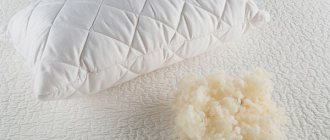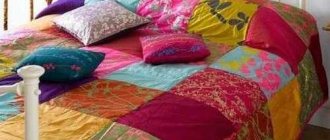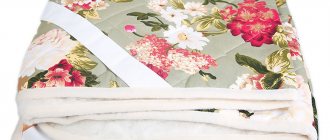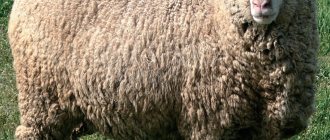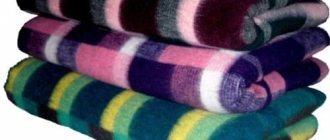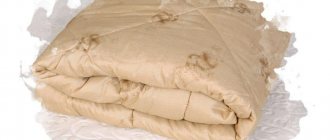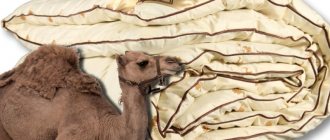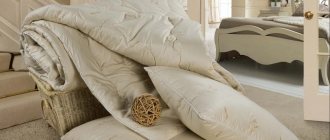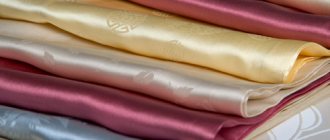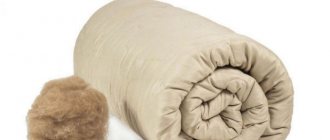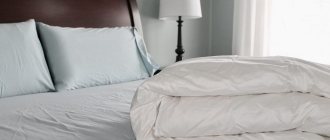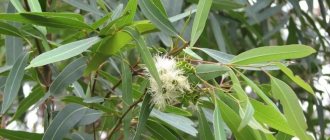A high-quality blanket made from Australian merino wool can be a real find for all lovers of warmth and comfort. It not only warms well, but is also able to harmoniously fit into any interior, creating a warm and cozy atmosphere. Due to their unique aesthetic and practical properties, such products are highly valued all over the world, but also require careful care from their owners during operation.
Description and characteristics of a merino blanket
Australian Merinos are a special breed of sheep renowned for their wool. Merino fleece sets them apart from other sheep breeds. Long merino fibers are ultra-fine and at the same time very durable. Soft and silky to the touch, they retain heat well. Due to these qualities, merino fibers have become very popular in the manufacture of blankets.
Benefits of merino blankets
Buyers appreciated all the benefits of merino bedspreads.
- Hygroscopicity. Merino wool has a valuable property: it absorbs moisture well. Under such cover a person does not feel sweaty: droplets of sweat are absorbed by the wool.
- Ventilation and thermoregulation. The special twisting of the threads leads to the formation of air layers in the wool base. This way natural ventilation occurs. At the same time, a constant body temperature is maintained.
- Practicality. The products remain clean even with daily use for a long time. This is due to the properties of the fibers: twisted into an elastic spring, they repel dirty particles and prevent them from accumulating. Therefore, it is enough to shake the blanket to keep it clean.
Reference! Natural fibers from elite sheep, absorbing up to 30% of their own weight, remain dry.
The smell of sweat also does not manage to penetrate the structure, so things do not acquire an unpleasant odor. Elite fibers retain their high-quality appearance for a long time, do not lose their shape, and the blanket filling does not crumple.
This is interesting: Togas brand bed linen: description of family collections from Greece
Drying and ironing
It is important to know not only how to wash 100% merino, but also how to dry it and whether it can be ironed. The retention of the product’s shape also depends on this.
Important points:
- It is better to wrap the item in a dry terry towel to remove excess moisture. You can gently press on the roll to squeeze out the water. Clothes can also be blotted with a cotton sheet.
- To dry, you need to lay the product out flat on a flat surface.
- It is advisable to dry in an open space, there should be no heat sources nearby.
- Wait until the item is completely dry before putting it away or putting it on.
Merino items usually do not wrinkle, so ironing is not necessary. If you need to do this, use a steam iron, but set it to ironing wool (select the appropriate temperature). Helpful Tips:
- Do not move the iron as you would when ironing regular items. Place it in the desired place, press down for a few seconds and remove, do this with all the wrinkled places.
- Pre-cover your 100% Merino item with a damp towel to protect the fibers.
Types and sizes
Merino wool is unique in its characteristics, therefore it is used in the production of various sleep products: blankets, quilts, blankets with open wool, bedspreads.
Blankets with open wool are especially popular. A blanket without a cover is in better contact with the body, which means the healing effect of merino wool is better. Such blankets are made using a weaving method in which the wool undergoes a minimal amount of processing and retains its healing properties. Opening blankets are light and thin, but at the same time warm.
There are varieties of such products:
- with open fur on both sides;
- with a sewn cover on one side.
Such products help improve blood microcirculation, improve metabolism, and protect against electromagnetic influence. Moreover, the absence of a cover ensures self-ventilation and ventilation of the product, which allows you to increase its service life.
Blanket sizes:
- 80x100 cm – for newborns;
- 110x140 cm – children’s;
- 150x200 cm – for a one-and-a-half bed;
- 180x210 cm – double;
- 200x220 cm – “euro” size;
- 240x260 cm – king size, maximum king size blanket.
The unique composition and properties of Australian merino wool have determined the use of this raw material in the production of blankets, rugs, and bedspreads for all age categories.
What types of wool blankets can be washed?
Whether a wool blanket can be washed depends on the type and production technology of the product. Products made from sheep wool are divided into three types. The most popular option is quilted wool, which is easy to use.
The product is covered with fabric on both sides and quilted over the entire surface. It practically does not fall off or get into lumps. The quilt can be washed either by hand or in a washing machine.
A one-piece blanket is a single, solid, thin fabric with high strength. The product cannot be washed in a machine, but hand washing is sometimes acceptable. Fur blankets are made by covering woven fabric with wool on one or both sides. The result is a fluffy and comfortable product, but this item cannot be washed. Dry cleaning only is permitted.
Blankets made from camel hair or goat hair can be washed by hand or in a washing machine if the label allows it. For any type of material, the washing conditions and rules are the same. Let's take a closer look at how to wash a wool blanket in the washing machine and by hand.
What are the benefits of merino yarn?
Wool is unique in its ability to maintain body temperature, preventing you from freezing in winter and overheating in summer. Delicate fleece, like silk, pleasant to the touch, has a positive effect on a person’s well-being:
- normalizes blood pressure;
- reduces headaches, back and joint pain;
- relieves muscle spasms and relaxes the nervous system;
- improves blood flow, facilitating the functioning of the cardiovascular system;
- relieves stress, giving joy and peace.
Warmth and comfort
Advantages and disadvantages
A merino blanket has the following advantages:
- Benefit for health. The warming dry warmth of a blanket has a beneficial effect on the nervous system, relaxes muscles, and reduces pain in joints and muscles. Relieves swelling and inflammation. Helps cope with colds by acting as an antiseptic on the body. The pile is harsh and has a massage effect. Lanolin fat, found in animal fur, rejuvenates, nourishes, and softens the skin.
- Normalization of temperature. The wool allows air to pass through and does not interfere with its proper circulation. This helps keep you warm in winter and cool in summer.
- Increased hygroscopicity. Such a blanket absorbs 30-35% of moisture from its own weight, both from the outside and from the human body. It quickly evaporates liquid and always remains dry and comfortable.
- Antibacterial. Lanolin kills harmful bacteria and microorganisms.
- The merino blanket breathes well. Curly hairs help air pass freely in any direction. No greenhouse effect is created. There is a feeling of freshness all the time. Lanolin neutralizes odors and other substances that penetrate here.
- Neutralization of static electricity. The products do not absorb dust and do not cause discomfort.
- Fire resistance. Each hair contains a small amount of water inside. On the outside there is a stratum corneum. It will require a higher temperature to ignite than other natural fibers.
- Self-cleaning. A constant flow of air refreshes the item, eliminates dust, skin particles and germs. The blanket remains clean for a long time.
- Adequate cost. Sheep wool blankets are much cheaper than other natural products. Only a wadded blanket costs less.
- The best wool from the withers of Australian Merino sheep is used.
A blanket made from natural merino wool has disadvantages:
- Provokes allergies. Dust mites, which cause asthma, love to live in natural materials. Wool and lanolin are allergens for some people. Therefore, the blanket is not suitable for newborns.
- It weighs a lot. A merino blanket weighs twice as much as a camel or down blanket. But some people find it easier to fall asleep under it, it’s calmer and more reliable.
- Tracks quickly. With constant use, the service life is less than the promised 10-15 years. The structure of the blanket is damaged, it becomes caked and unusable.
- Difficult to care for, not machine washable.
On a note
Given these properties, the products are not suitable for small children. But a non-allergic child of two or three years old can buy such a thing. It will warm or cool him depending on the time of year. If the child sweats, quickly absorbs and releases the sweat, sleep will be calm and comfortable.
Is it machine washable?
Taking good care of the product means delicate hand washing using conditioner. Careful flat drying and light ironing with a warm iron are required.
Full relax
If a triangle is drawn on the product label, then machine washing is allowed, but it is worth considering a delicate cycle and a water temperature of no more than 30 ° C. A lot depends on the composition of the raw materials from which the blanket is made.
Note! It is possible to add sheep wool fibers from other breeds, making the fleece more resistant to washing.
The manufacturer depicts a bowl of water on the label if the product can be hand washed. In this case, it is possible to use gentle products that exclude the presence of chlorine for bleaching.
You might be interested in this. Detailed description of Mongolian cashmere from the Gobi factory
The absence of appropriate signs indicates that you should limit yourself to dry cleaning the rug without using water. Increased attention to an expensive product that competes with alpaca products will extend its service life.
Plaid after washing
How to properly wash a merino wool blanket
It is not always possible to get rid of dirt with just dry cleaning. Shaking and periodically drying with fresh air ventilation will eliminate the need to wash the blanket.
It should be noted that if washing cannot be avoided, then the correct actions will keep the fibers in their original form. Using smooth movements without much friction, wash the blanket in warm, comfortable water with the addition of conditioner.
Note! Prolonged soaking and washing in hot water can lead to shrinkage of the product, and not always symmetrically. A large knit merino blanket requires a special approach to cleaning it from dirt.
Merino wool blanket
Frequent washing is not recommended by the manufacturer. This is justified by the fact that knitted wool is even more delicate than sheep's down, which does not require periodic washing and cleaning. Stains can be removed with ordinary white laundry soap, rinsing off the residue with warm water.
Is it possible to wring out and how to dry?
The product should not be twisted, like most knitted wool items. By squeezing a blanket, you can disrupt the structure of the fibers, so it is recommended to leave the product on a special rack or place it at the bottom of a basin so that the water can drain naturally. When the excess moisture has drained, you need to lay out the blanket, leveling it over the entire area.
Factory plaid
Proper drying of the blanket in a horizontal position will ensure that it retains its shape. Excess moisture can be collected with a terry towel. The use of hair dryers and heaters is prohibited. Drying in the sun is not recommended. There is no need to iron the blanket.
Washing machine care
Prolonged exposure to water damages woolen items. Therefore, it is better to refuse washing in an automatic machine. An exception is made for small items. Knitted hats, socks, mittens, and thermal underwear are loaded into the washing machine. For sweaters and blankets, hand wash only.
First, things are turned inside out. It is advisable to wash on a delicate cycle without using a spin cycle. The preferred temperature is 40 degrees. If you set the water settings to too hot, things will shrink after washing.
Recommended speed is no more than 600 rpm. When washing, do not mix different materials, as the woolen fabric will become covered with pellets. The only fabric that can be washed with wool is denim. Fabrics of different colors are washed separately so that the color saturation of the products does not change.
After washing, woolen items are immediately removed from the device and dried. If they are left for half an hour or more in the drum of the washing machine, the fabric will become deformed and lose its shape.
Sizes and prices
The appearance on the market in 2015 marked the beginning of sales of merino blankets in the Russian markets. Making bedspreads by hand, from children's bedspreads measuring 70x70cm to double bedspreads measuring 200x210cm, brought quick success.
Therapeutic blanket
Prices are determined by thread consumption and volume of work and range from 2,900 to 12,900 rubles.* Blankets with large knitting are made to order. Finished products of non-standard sizes can reach a cost of up to 141 thousand rubles.
Blanket as a gift
The main companies that produce blankets in Europe are OHHIO, DollyWool, ModernWool.
You might be interested in Description of gauze: types and uses of fabric
| OHHIO | DollyWool | ModernWool | |
| Blanket sizes | from 40×60 cm to 152×203 cm | from 70×70 cm to 200×210 cm | from 90×120 cm to 230×260 cm |
| Number of colors | 14 | 14 | 5 |
| Prices | from 12,594 to 40,500 rub. | from 2900 to 12,900 rub. | from 31,000 to 141,000 rubles. |
Coat for baby
You can purchase a blanket:
- as an expensive gift for a wedding or anniversary;
- for home use:
- for relaxing in the car or on a picnic;
- as a shawl on the shoulders for work;
- as a healing blanket;
- for decorating a living room or bedroom.
Merino blanket
Expensive natural material is difficult to care for, but brings a lot of pleasant sensations to the owner. The remarkable qualities of a blanket made from the finest pile are preserved for several decades if the product is treated with care.
Handmade by a master
*Prices are as of June 2021.
This is interesting: Furniture covers: types, types, materials, design
Rules of care
It will be possible to wash products much less frequently if you ensure they are properly dried after each use. Wool absorbs moisture well. Therefore, after sleep, hang the blanket in the fresh air for at least 15-20 minutes. If this is not possible, then take the blanket out into the fresh air once a week or two, but for the whole day. For drying, be sure to choose dry, sunny weather. The presence of moderate wind will enhance the effectiveness of the procedure.
If a stain appears, it can be washed separately. To do this, it is not necessary to wet and wash the entire product. You can easily remove dirt at home using the most common means.
For long-term storage, use only special covers made of highly breathable fabrics. Ideal - cotton. But even in this case, it is better to periodically take out a blanket or blanket and dry it in the fresh air, since such products are an excellent haven for dust bugs.
It is important to strictly follow the recommendations on the label when washing and not to overdo it during the spin cycle.
Varieties of merino wool blankets
The industry today offers a large selection of merino bedspreads. They vary in weight, size, and design.
Lightweight, lightweight, standard merino wool blankets
The weight of the product depends on how tightly woven the fibers from which it is made are. There are 3 types of products based on weight.
- Lungs. The threads in these bedspreads have the lowest density. 1 m² of material weighs 150 g.
- Lightweight. In their production, medium thread density is used. As a result, 1 m² weighs twice as much as light ones - 300 g.
- Standard. The tightest threads are woven in standard blankets. That's why they weigh more than the others. Weight 1 m² - 400 g.
Reference! Light bedspreads are best used in warm weather. Lightweight ones can be covered throughout the year, especially if the bed is located in a room that is drafty or has high humidity. Standard ones are designed for the lowest temperatures.
Appearance and content
Products differ not only in weight. Their design also varies: with and without filler.
Merino blankets are produced in 2 types:
- with wool filling inside the case;
- without filler, made of woolen fabric.
Surface:
- Varieties with filling have covers made of satin or cotton.
- Unfilled varieties come in all wool or have merino fabric on one side. For the second side, natural (satin) or synthetic fiber is used.
It is believed that to achieve a healing effect, wool must have direct contact with the body.
Reference! The price of things depends on their type and the amount of elite fiber used. The least expensive are blankets with a cover with filling, the most expensive are products made entirely of wool.
Merino blanket sizes
Given the uniqueness of merino bedspreads and their use for a variety of purposes, manufacturers produce products in different sizes.
For children:
- Newborns and infants: 0.8 m x 1 m.
- Children under 10 years old: 1.1 m x 1.4 m.
For adults:
- Single bed: 1.5 m x 2 m.
- Double bed: 1.8 m x 2.1 m.
- European size: 2m x 2.2m.
- Maximum (“royal”) size: 2.4 m x 2.6 m.
Does merino wool shrink when washed?
After washing merino wool, it shrinks when using hot water or during sudden temperature changes (for example, if you wash in hot water and rinse in cold water), and increases in size if it is not dried properly, twisted, or other errors. Deformation of an item immediately after washing is most often the result of non-compliance with recommendations. Therefore, please read all the information below carefully.
An important point: merino clothing will stretch if you wash it very often. Experts advise doing this no more often than once every 3-6 months.
If you are going to knit something with merino wool, wash at least a small sample first to see how the merino behaves after washing, especially if the yarn is mixed (with other wools or acrylics). After the first wash, the new yarn may change slightly in size (usually it stretches), but subsequent times with proper care there should be no other changes. The size of the knitting needles is also important. Tight knitting also helps the product maintain its appearance.
New clothes may expand slightly after the first wash, but again, a lot depends on the process itself.
During drying, the shape of the product may differ from the desired one. Wait until it dries completely, only then does the item take on its size.
Advantages
Finished products made from merino wool have the following advantages:
- natural ingredients are hypoallergenic;
- During sleep, the body remains dry at a constantly maintained temperature, thanks to increased hygroscopic properties. Wool can absorb up to 1/3 of its own volume of moisture, while the fibers remain dry;
- natural material self-ventilates and allows the skin to breathe;
- The thermoregulation properties of the product are achieved thanks to the twisted structure of the fibers, which create air layers in the product;
- natural material does not absorb unpleasant odors, and the porous structure prevents the accumulation of dust and dirt;
- antiseptic properties and therapeutic effect (for diseases of the musculoskeletal system, colds, to stimulate metabolism) are provided due to the content of natural lanolin in the fibers;
- use of the highest quality raw materials from the withers of Australian Merino sheep;
- long service life of the product due to the elasticity of the fibers, which, after deformation, return to their original shape.
These unique characteristics of products made from merino sheep wool are responsible for their high cost.
What not to do
- Soak the merino product for a long time, at most 5 minutes.
- Twist merino wool when washing and spinning, otherwise it will become deformed and stretch.
- Use hot water (above 30-40°), boiling. And during washing, sudden temperature changes in the water are not allowed.
- Use bleaches. If difficult-to-remove stains appear on clothing, you need to find a way to remove them without aggressive agents.
- Dry vertically (on hangers, etc.). Do not use a hair dryer, battery or other similar methods.
- Use a clothes dryer. If the item does not indicate that it can be dried in a machine, refuse it. If allowed, choose delicate mode.
How wool is made into fabrics
Sheep shearing to obtain raw materials is done manually, then goes through the following processing steps:
- sorting;
- wash;
- separation of fibers using a special machine;
- combing wool and obtaining roving (thread) on a machine.
Then follow the stages of weaving and processing the fabric, depending on the purpose of the raw material, including dyeing.
For standard fabrics, threads with a cross-sectional value from 15 to 22.6 microns are used in production. The finest merino fabric is made in Italy from fibers purchased in New Zealand, less than 12 microns thick, and is called “Gift of Kings”. This is a rare type of material, and its annual production is limited, and the cost of such fabric is comparable to the cost of a car. This is because they get very little of such fine fibers when shearing merino sheep - 2000 kg per year.
Preparing for washing
It is very important to choose the right detergent. For wool, a specialized liquid shampoo or gel would be a suitable option. You can also use an all-purpose pH-neutral powder that contains no bleach or chlorine.
Do not use classic powders! They damage the structure of the coat and are difficult to wash, often cause allergies and do not remove difficult stains. In addition, they are harmful to health. In exceptional cases, such cleaning products can only be used to wash a cover, duvet cover or pillowcase.
To hand wash a camel blanket, regular laundry soap is also suitable. Pre-grate the bar and dissolve in cool water until foam forms. Then add the product to the water bath where you will wash your clothes. To hand wash a sheep's wool blanket, you can make a mixture of liquid pH zero soap and a tablespoon of borax.
Before washing, beat the blanket or blanket well to remove dust particles and small dirt. This will improve the washing result and simplify the process. Let us repeat once again that hand washing is preferable for woolen items.
How to choose?
A merino wool blanket is not a cheap pleasure. Therefore, his choice must be approached responsibly, with knowledge of the matter. What factors should you consider when purchasing it:
- Fluctuations in indoor temperature depending on the season and weather.
- Features of your own body: whether you are “freezing” or like it when it’s cooler.
- Do you like thick or thin blankets?
- Do you sleep alone or together?
- Do you prefer the product with a case or not?
You should also pay attention to the following product features:
- How the blanket is sewn . There are 3 types of tailoring: parallel quilted, stitched with “squares” or the so-called karostep - patterned stitching. It is preferable to choose the 2nd or 3rd types.
- What is the cover made of (if any). It is recommended to opt for calico, satin or jacquard fabric. They are natural, breathable, quite durable, last a very long time, and are pleasant to the body.
- Information on the label. The following must be indicated: the manufacturing company, in which country it was produced, care recommendations, materials for making the cover and filler. The completely natural “filling” is accompanied by the NOMITE mark.
- Presence or absence of odor. It is worth paying attention to whether there is an admixture of “chemistry” in the aroma. It shouldn't exist.
- Workmanship. Good manufacturing companies carefully monitor the performance of their products and exclude defective goods with protruding threads and crooked stitching.
- The information on all product labels and tags must be completely identical.
How to dry it properly
Dry only in a horizontal position and after maximum water has drained. The product must be laid out on a hard surface. Place another blanket, blanket, or towel underneath. The base must have strong absorbent properties.
The base should be changed periodically to a dry one. This will reduce drying time. After the product has dried, you can hang it on a rope. This will complete the process and prevent moisture from accumulating inside the blanket.
Thus, washing a blanket made of sheepskin or the hair of another animal at home is not so easy. The process will take a lot of effort and time. but if you periodically carry out such a procedure, then you will be able to enjoy for a long time the pleasant warmth and softness that it gives to its owner on long nights.
Many housewives are annoyed after washing when they see that their colored linen has faded. How to wash correctly, Items made of viscose look very beautiful and bright, but due to improper care they become very fast, Natural fabrics are expensive, but cause certain difficulties when washing. To remove contaminants you will need, Properly washing and drying a down jacket is a whole science, because due to poorly selected
Advantages and benefits
One of the most surprising and positive features of sheep's wool is its “three-dimensional” structure . Long downy fibers of wool, clinging to each other with their curls, form millions of air pockets. Thus forming an airy, soft, warm, elastic material that does not bunch up or form lumps.
Thanks to this structure, a product made from sheep wool has the following unique qualities:
- Effectively retains heat and maintains temperature balance due to the air between the wool fibers. It's neither hot nor cold under a sheepskin blanket.
- Absorbs moisture well , unlike synthetic products. At the same time, it remains dry and warm, as it easily evaporates the accumulated moisture.
- Sheepskin blankets are light and airy .
- Sheep wool is considered fireproof , since each wool contains water and is covered with a special cornea; its combustion requires a very high temperature than for products made from other natural fibers.
- It has an antistatic effect , does not accumulate dust and is not electrified.
- Due to the movement of air in the structure of the filler, self-cleaning from dust and sweat .
- Wool fibers are coated with a natural antiseptic (lanolin), which effectively destroys toxic substances contained in sweat and prevents unpleasant odors from being absorbed.
- The affordable price of the product is of no small importance . Unlike other natural fillers, sheep's wool is not as expensive. The double-sided woven blanket option is the most luxurious, but also considered the most expensive.
- A product made from sheep wool is considered hypoallergenic . Cases of allergies are very rare.
- The medicinal, healing properties are considered an undoubted advantage . The above-mentioned lanolin is used by pharmacists and cosmetologists to make antibacterial creams and ointments. Heating up overnight, microdoses of lanolin enter the human body and heal it. A blanket around the human body creates an aura of dry heat, which has a positive effect in the treatment of bronchitis, radiculitis, diseases of the joints and spine, muscle tissue relaxes, thereby restoring blood circulation, and normalizing heart rate and pulse. Blankets with exposed wool are believed to have the greatest healing effects.
How to wash by hand
It should be noted that washing such a product by hand is not easy. Wool quickly absorbs water and becomes very heavy. In addition, it is difficult to rinse and wash. Each stage requires a serious approach; mistakes are unacceptable. Spinning can permanently damage the product, and improper drying will cause the development of fungi and bacteria inside the blanket or blanket.
Procedure for hand washing a sheepskin blanket:
- Fill the bathtub with cool water. The temperature should not be higher than 30 degrees.
- Add a special product. You can use wool detergents or baby shampoos. But it is better to give preference to special formulations that contain lanolin. This substance protects fabric fibers from deformation.
- Whip into thick foam.
- Place the blanket in the bath.
- Leave for 5-10 minutes. You can't rub or pull it.
- It is only allowed to lift and release the blanket with gentle movements.
- Now you can start rinsing. Do this until all the detergent is completely rinsed out. You need to drain and refill the bath with cool water. This will take a large amount of water, but the result largely depends on the correctness of the manipulations.
Once the rinsing is complete, the blanket can be left to drain. Then place a chair under it and let more water drain. This will make it much lighter and easier to lift. The more moisture is removed, the less time it will take to dry.
Who are Merinos?
Merinos are a very special, elite breed of sheep. It is believed that it was bred in Spain in the 12th century, however, after they were brought to Australia in the 18th century, sheep began to be bred almost exclusively there. The reason was the special Australian climate, favorable for these animals. Merino sheep differ from ordinary sheep in their small size; they are not kept for food. The main trump card of these cute creatures is their luxurious wool, from which they make things of amazing quality.
This is due to the fact that merino wool fibers are very light, weightless, thin, but at the same time they are durable and have a high density.
History and description
Merino sheep are primarily found in Australia. Nowadays, it is from there that the largest amount of wool and products are exported. In the 13th century, the breed was developed by the Spaniards, and for the next 5 centuries, the export of sheep and products was punishable by death.
In the 18th century, several sheep were exported to various countries, including Australia. Now most wool, products, and blankets are exported from Australia. In other countries their number is insignificant.
Merino is a fine-wool sheep breed that is raised specifically for its wool. They differ from meat breeds in size. Merino wool is thin, but dense and durable.
Care instructions
Caring for products made from merino fabric is simple:
- The fabric can only be washed by hand. The water temperature for washing is selected depending on the manufacturer’s recommendations and is no more than 60 degrees;
- Products can be cleaned using special products. They resort to this infrequently, since the material has dirt-repellent properties. Cleaning needs to be done by special services;
- You cannot wring out the products! Dry flat on a soft surface, for example, a towel, in a well-ventilated area;
- pillows, rugs and blankets are not washed. They need to be immersed in water with detergent for a few minutes, taken out, allowed to drain and laid out to dry without twisting;
- To restore the color of an old product, just keep it in water with lemon juice added to it.
Washing features
It is better to wash merino fabric using special products marked “for wool”. They take good care of them and do not damage the fibers. Wool gels protect the material from shedding.
For hand washing, the special composition can be replaced with other products. Liquid soap is suitable for washing. It is better to choose one with a neutral pH. Instead of soap, dishwashing detergent is also used.
It is better to avoid washing powders. Grains of the product get stuck in the fabric, which can cause allergies upon contact with the skin. Bleach also deteriorates the properties of wool.
Choice
A series of warm blankets Magic Night filled with natural merino wool brand Nordtex
Things to consider before purchasing:
- the time of year for which the item is intended;
- how the body tolerates different temperatures, whether it likes coolness or warmth;
- comfortable under a thin blanket or like the security of a heavy one;
- it should be in a cover or with the wool facing out.
What to look for when purchasing:
- Case material (if available). The best options are natural jacquard, satin or calico. They are strong, durable, breathable, and pleasant to the touch.
- A blanket made from Australian merino wool must be marked with the source material.
- Presence of odor. Sheep wool has it, but it may not exist if all technologies are followed. There definitely shouldn’t be a chemical or unnatural smell. Even if the composition is completely natural, these may be the consequences of chemical processing that should not exist.
- A high-quality blanket, with or without a cover, does not have lint sticking out. You can get them from the inside with some effort. There should be no crooked stitching or protruding threads.
- Quilting options: parallel, squares or patterns. The last two are better.
- Weight and cost of the product. If it is light or costs up to two thousand rubles, it means there are synthetic impurities.
- The label of a good product indicates the density, weight, composition of the filler and cover, dimensions, and care tips.
- 100% natural merino filler is marked with the word NOMITE.
You should only buy a blanket for your child if it fits. There are different sizes, even for the smallest ones. If the child does not mind a heavy blanket, you should take a larger size. Children grow faster than the life of the blanket. But if you have allergies, it is better to go with the synthetic version.
Important
For the healing properties to be effective, contact between fur and skin is necessary. You will need a pure wool blanket without a cover or duvet cover.
Dimensions
The merino blanket has the following dimensions:
- for infants, newborns 80x80 cm or 80x100 cm;
- children under 10 years old 1.1x1.4 m;
- single bed 1.5x2 m;
- double bed 1.8x2.1 m;
- European version 2x2.2 m;
- king size 2.4 x 2.6 m.
These are commonly found sizes for merino blankets.
Instructions and quality of the item are the key to maintaining its shape
It has been noticed that high-quality products made from merino wool, if all recommendations are followed, perfectly retain their shape. We delight our customers only with proven items. We have clothes made from 100% merino wool, as well as with the addition of acrylic. We offer you good clothes at manufacturer's prices!
Always follow the care instructions written on the item's label! It may differ for different merino products.
We will give you general recommendations on how to wash merino wool and specific types of products. This is especially useful if you have a hand-knitted item or have lost the tag.
What to look for when choosing merino blankets
When choosing, the buyer must first determine exactly what product he needs.
It depends on your own preferences regarding temperature, as well as on who it is chosen for (children or adults), and in what season it is intended to be used. During the purchasing process, you need to carefully consider the item, paying attention to the following points. Label. It should contain all the information about the composition of the material (and the cover), the manufacturer, and the rules of care.
Workmanship. High quality is evident in every seam and line on the product. There should be no crooked or broken lines or protruding threads.
Smell. If the product has even a slight “chemical” smell, this should alert you. Such “aromas” indicate the presence of synthetics or chemical processing of fibers that is not allowed by traditional production.
Cover and sewing method. It is recommended to give preference to products that have cotton covers rather than synthetic ones, which are stitched with squares or patterns.
Varieties
They are determined by two factors: mass with density and appearance.
Density and mass
There are three types of blankets:
- Lightweight with a density of 100-150 g/sq.m. m. Suitable for summer use.
- Universal lightweight ones with a density of 250-300 g/sq. m. Suitable for any time of year. They warm well in damp rooms with drafts.
- Standard 350-400 gsm. m. It is comfortable under them in winter in the north. Sometimes their density varies up to 800 g/sq.m. m.
The weight of the product increases in direct proportion to its density.
Appearance
According to this criterion, merino wool blankets are divided into three types:
- Quilted closed options. The fabric shell is filled with wool and quilted together. The wool layer can be thick or thin, there is a blanket for every season. Covers are made from wear-resistant natural or mixed materials - satin, cotton, calico, polycotton.
- Open wool blanket. On one side there is fabric (usually satin or synthetic), on the other there is wool. They are suitable for summer or off-season; in winter they can be cool.
- Pure wool blanket. Costs more than previous options. More comfortable and pleasant in appearance.
Quilted ones are the most common and inexpensive. They will last longer and suit most people.
Products may vary in density and aesthetic appearance.
Based on density, the following types can be distinguished:
- lightweight merino pile blanket, density 100-150 g/m2. m. Convenient for covering in warm weather;
- universal with a density of 250-300 g/m2. m. Will keep you warm in any weather;
- standard – 350-400 g/sq.m. m. They will keep you warm even in severe frosts; you can even find products with a density of up to 800 g/sq.m. m.
Based on their aesthetic appearance, products can also be divided into types:
- blankets covered with fabric on all sides, the wool is inside. The density may be different, the fabrics also selected are different;
- with an open wool side and a closed fabric side on the other. Lighter options for warm weather;
- completely wool, the cost is higher, but the appearance is more beautiful.
We suggest you read How to wash linen curtains
Rules that will help extend the life of a merino wool blanket
It is advisable to make holes in the storage bag so that the blanket “breathes”, this will make it last longer.
When airing outdoors, hang the product in the shade; under the sun's rays it will lose its brightness.
Rolling of wool cannot be avoided; when pellets appear, they can be carefully cut off with scissors; you should not pull them out with your hands, this will lead to the formation of new pellets.
A merino blanket can give comfort, warmth and coziness to its owner. And also improve his body. You need to make your purchase wisely, choosing only reliable manufacturers to get a quality product.
Expert recommendations
To ensure that the item continues to please you with its appearance and service, follow a number of easy-to-follow recommendations. More details:
- Do not soak the blanket for a long time - a quarter of an hour is enough.
- Make sure that air enters it from all sides. With heavy options, you can use a horizontal bar and spacers for the sides.
- It is better to add too little cleaning agent than to add too much.
Often, washing a wool blanket seems like a feat that not everyone is capable of. However, if you know how to tackle this matter correctly, then anything can be put in order even without resorting to the help of professional “cleaners”.
Who are merino wool blankets recommended for?
A blanket made of merino wool can help relieve pain in muscles and joints, has a calming effect on a person, and balances blood microcirculation.
The unique properties of the material can also protect against external harmful factors, neutralizing toxins and electromagnetic radiation.
The hypoallergenic nature of the material is also an advantage, because even a child can be covered with it.
A merino sheep blanket has a large number of positive characteristics, the mention of which can help you make your choice:
- softness and tenderness, very pleasant to the touch, does not prick;
- the uniformity and smoothness of the coating makes it so beautiful, and is also a wear-resistant and durable product;
- there is no bright sheep smell, it is very faint;
- does not shine, the glare from it will not fall into the eyes in the sun;
- noiselessness, will provide a restful sleep.
A merino blanket is suitable for everyone who wants to have a wool blanket, but is not ready to tolerate some of the characteristics of wool:
- those with sensitive skin, including children of any age;
- people who have problems with thermoregulation (most often these are elderly people and children).
When choosing, pay attention to the size of the product. The size range allows you to choose a blanket for different purposes:
- as a blanket for an adult – 140x200;
- like a blanket on the road - 100x150.
The composition is also important; naturally, the price increases depending on the naturalness of the material. Using other materials will reduce the cost, but the properties will also become worse.
And of course, you need to choose a suitable color for the blanket, one that will please the eye.
There are specifics to storing a woolen blanket; it should be stored in a cotton or canvas case. You can also leave moth repellent nearby.
Having taken it out of the bag for further use, you should straighten it and let it lie on a horizontal plane so that the hairs straighten and fluff up. It should rest for a day or two.
Washing products made from merino wool is not prohibited, but some manufacturers may indicate on the label that the blanket cannot be washed, then their recommendations should be followed. And if you take it to the dry cleaner, you must tell its employees that the material of the blanket is merino wool.
You can remove a small stain yourself, moisten the area with water and soap a little, rub, rinse off the soap, and dry it in a straightened form, after shaking the product.
We invite you to read: Is it possible to do laundry on church holidays?
The blanket can only be washed by hand; the water temperature is set at 30 degrees. The powder used is specialized (for woolen products). You should always dry it flat, preferably placing a cotton cloth underneath it. The blanket is periodically shaken and turned over during drying. Do not place it near heating devices or in the sun.
It is forbidden to wring out or twist the blanket.
Merino wool is unique, it has antibacterial properties, is very soft and does not itch at all, and absorbs moisture well. At the same time, merino wool is incredibly light and even bulky items, such as a merino wool blanket, will be almost weightless.
Merino wool is produced from the fine-fleece Merino sheep of the same name. This is a special breed of highland sheep from Spain that was brought to Australia and New Zealand in the 18th century, where they are now bred. Australia has become the world leader in the production of merino wool.
Merino sheep are valued for their high ability to produce wool; up to 15 kg can be obtained from one sheep per year. wool, while representatives of other breeds produce only 6-7 kg. wool per year. The main value of merino wool is that it is light, hypoallergenic and very thin, its thickness is 15-23 microns, while other sheep breeds have a wool thickness of 24-35 microns.
Depending on the thickness of the hair, merino wool is divided into 4 conditional categories; the thickest hairs, 20-24 microns, are the cheapest and most common, they are suitable for machine knitting. Large knit blankets are also knitted from this wool, which have become popular.
The finest merino wool is called Summer wool, the hair thickness is only 14-15.5 microns, its volume is only 0.1% of the total merino wool production and is sold at special annual auctions. Golden Bale summer merino wool is used to make very expensive fabrics and knitwear.
Even the least expensive merino wool is quite expensive and therefore a certain amount of synthetic threads is added to it to reduce the cost. By the way, the color of merino wool is exclusively white.
1. Protection from moisture. The fibers absorb water without becoming wet. The human body remains dry. The fabric neutralizes the smell of sweat, so it is suitable for daily wear.
2. Thermal insulation. Wool retains heat and is suitable for wear in low temperatures. Clothing made from this fabric is suitable for people prone to illness. It improves well-being in diseases such as bronchitis and colds. Dry heat helps cope with osteochondrosis, reduce joint and muscle pain due to arthritis and radiculitis.
3. Comfortable heat dissipation. In merino fiber, a person does not feel either cold or heat. The fabric adapts to environmental conditions. Due to this quality, merino wool is recommended to be used for clothing for newborn children. In the first months of life, babies have not yet developed the necessary thermoregulation, so the fabric will allow them to constantly feel comfortable.
4. Soft fiber. Woolen clothing is often discarded because it is too rough and harsh on the skin. Merino fabric is smooth and silky to the touch.
5. Good fit. Merino wool fiber is fine enough to highlight the silhouette. It does not create excess volume and fits the figure.
6. Eco-friendly. The material is made from natural fibers. It does not cause allergies and is suitable for sensitive skin. Bed linen is made from merino wool. You can sleep on it without using pillowcases and duvet covers. The structured fibers are pleasant to the body and provide a beneficial massage for the skin. A bed made of such material relieves signs of fatigue and helps relax muscles. Thanks to this, sleep is complete and sound.
7. The fabric retains heat, so it is suitable for making thermal underwear. It is also used to create casual clothing. Merino fibers are easily dyed in bright and rich shades.
The fabric can be gently squeezed to remove excess moisture. It is not advisable to dry the item with twisting movements. To ensure that the product dries without becoming deformed, it is wrapped in a terry towel. Excess moisture is removed by blotting clothes with a cotton sheet.
The wool is dried in a horizontal position. It is recommended to lay out the products to avoid creases. When dried vertically, woolen items stretch and sag. The fabric should not be dried on radiators or near other electrical appliances.
